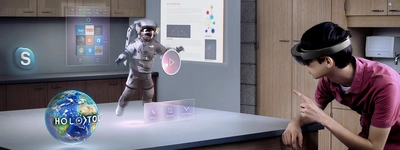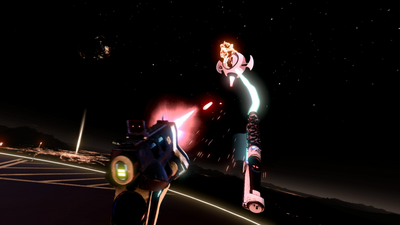
Please install a more recent version of your browser.
6 June 2017
5 minutes read
Space Pirate Trainer, I-Illusions
What if we told you that, within a mere 25 years, gamers will no longer need powerful machines and high-definition screens to play their favorite video games? All that will be required at that point is a high-tech lens. A window onto your version of reality. Whether this evolution will really happen at such breakneck speed is still unsure, but one thing we do know: what used to be the stuff of science fiction is becoming a reality. Is this just the umpteenth technology bubble? We got in touch with two homegrown experts, Bernard François (PreviewLabs) and Dirk Van Welden (I-Illusions), and they don’t think so ...
As a novice, you probably won’t be able to tell the difference between an Oculus Rift, a HTC Vive (virtual reality) or a HoloLens (augmented reality/mixed reality). Yet despite the fact that all of these big headsets or head-mounted displays (HMD’s) make you look a bit cyborg-ish, the technologies are miles apart in function and use.
The key difference is that virtual reality takes players to another world by completely replacing reality with a simulation, whereas augmented reality optimizes the perception of the real world using virtual elements.
Instead of staring at your GPS screen, you could use AR to project the directions directly onto the road.
At PreviewLabs, a company that specializes in rapid game prototyping, Bernard François and his team don’t build their own games but rather turn their clients’ ideas into playable prototypes. With lots of successful VR projects under his belt, François is currently exploring the ins and outs of HoloLens, Microsoft’s AR/MR technology. “Applications are our main focus right now, but that doesn’t mean HoloLens has no potential as a gaming platform.”

Bernard François, PreviewLabs
Of all the gaming concepts that are currently available for download at the HoloLens Development Edition (you can only buy the AR/MR device online for now, via the Microsoft Store), none appeals more to the imagination than Fragments. After your living room (or any other room you game in) has been scanned by the HoloLens, it transforms into a true crime scene. Players assume the role of a detective who is looking for clues (that can be hidden between real objects!) and they have to talk to holograms of characters lounging on their couch.

HoloLens, Microsoft
Interesting content is what gets new technologies off the ground. Dirk Van Welden (I-Illusions) knows this first-hand. Disappointed with the lack of action in the demos of the HTC Vive prototype, he decided to take matters into his own hands. The second prototype that sprang from his brain was Space Pirate Trainer, a VR interpretation of the arcade classic Galaga. The concept turned out to be a smash hit, so it wasn’t long before software company Valve invited him to Seattle to show the assembled press just what the game (and, by extension, the Vive) has in store.

Dirk Van Welden, I-Illusions
With more than 100.000 copies sold, Space Pirate Trainer is one of the absolute VR blockbusters.
This VR stunner not only sold like hot cakes, it was also loaded with important awards, not least among them three Proto Awards, the officious ‘Oscars’ of the VR industry.
Up to now, Van Welden and his team have been tweaking the game, the final version of which will be resealed this fall. “I think of it as a service for the people who have supported us from the very beginning.” What his life will look like after Space Pirate Trainer? Van Welden doesn’t know yet. “First of all, I need a good idea. I’m tempted to try my luck at VR again because I know the territory so well by now.” It is hard to imagine, but Van Welden actually got so sick playing one of the first prototypes of Oculus Rift that he feared VR just wasn’t for him.

Space Pirate Trainer, I-Illusions
Selling 100.000 copies of a game obviously helps to fatten up your piggy bank, yet it is peanuts compared to launching a bestseller in console games. After all, the fact remains that only a handful of people own VR glasses.
The technology’s impressive price-tag definitely contributes to that situation. For a HTC Vive or an Oculus Rift with touch controllers you easily pay between 800 and 900 euros, not to mention the fact that you need a strong computer to do something with it. Another downer is that the current technology restricts your movement, because neither the Oculus Rift nor the HTC Vive are wireless. There are wireless alternatives in the pipeline, but they tend to lack processing power. The wireless HoloLens works completely autonomously, but it comes with a hefty price tag: the AR/MR device costs between 3.000 and 5.000 euros.
Both François and Van Welden are convinced that ease of use and lower prices are vital to attract a bigger audience.
Thanks to its many applications in addition to gaming, the technology could be interesting to a very wide range of consumers.
And the technology never fails to amaze people. Van Welden: “When I do a Vive demo, my audience is never disappointed” – a living proof that the technology works.
Though the breakthrough to a wider audience is not yet in sight, there’s no reason to panic. Think of the computer mouse, which was introduced in 1967 and first sold for 299 dollars in 1983. It took years for the digital rodent to find a way into people’s hearts (and hands). The mobile phone needed even more time to settle in. Invented in 1973, the device appeared on the market in 1983, but only in the new millennium did it spark a wider interest. It’s clear that the virtual dimension still has plenty of time to make itself at home in our daily lives.
This transition obviously won’t happen overnight either. It takes a killer application to accelerate the adoption process and both gentlemen are looking towards social media to make this happen. Whether this will be the death of traditional gaming platforms remains to be seen, though it is already possible to stream Xbox One titles to an Oculus Rift without using a screen.
So it is not unthinkable that even the classic gaming experience will gradually move into the virtual world.
You could object that VR/AR technology has failed to leave a mark before, but according to François, that argument doesn’t hold water. “Previous attempts to introduce VR date back to a time when many families did not even have a computer or were not familiar with digital interfaces. Today, both the people and the technology are ready for it.”
Cookies saved